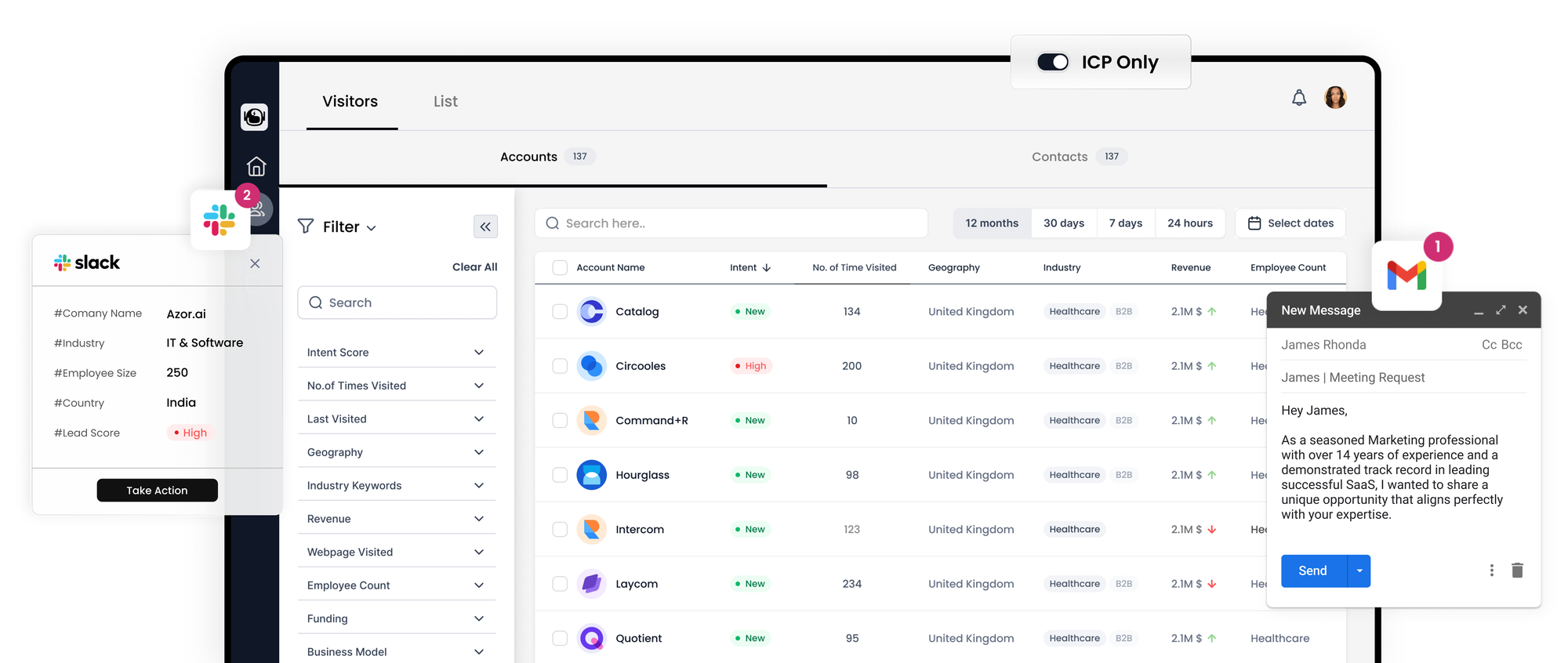Navigating B2B Marketing: Strategies for Success in 2024

Conquering the realm of B2B marketing presents its unique set of challenges.
While consumer marketing is a familiar playing field, engaging a boardroom full of decision-makers presents a whole different game – not to mention the bureaucratic hurdles and specific pain points that demand tailored solutions.
Yet, for every B2B enterprise, there are effective strategies to reach and persuade.

Understanding B2B Marketing
B2B marketing stands for business-to-business marketing. It encompasses the strategies and content that one company leverages to capture the interest and patronage of another. This is common among firms offering services, products, or software solutions to other businesses or organizations.
Take, for example, Monday.com's B2B strategies on LinkedIn or Gong's innovative approach to Super Bowl advertising. These are business marketing solutions that streamline or improve business operations for other companies.
The core objective of B2B marketing is to generate and nurture leads until they become paying customers. In today's fast-paced digital world, this entails grabbing a prospect's attention swiftly and maintaining their engagement through educational and value-laden content, such as white papers or insightful blog posts.
Distinguishing B2B from B2C Marketing
Having addressed "What is B2B marketing?" it's essential to discern how it diverges from B2C marketing.
The distinctions between B2B and B2C marketing primarily revolve around the targeted audiences:
B2C marketing appeals to individual consumers who purchase goods or services for personal use. B2C entities cater to the needs, interests, and impulsive buying behavior of individuals, focusing on immediate satisfaction rather than a calculated return on investment.
Products typically sold to consumers range from daily necessities like toothpaste to casual purchases like clothing.
B2B marketing targets individuals or groups seeking solutions for their company's challenges. For instance, sales automation software that simplifies B2B prospecting falls into this category. The B2B purchasing cycle is notably more extended due to the involvement of numerous stakeholders influencing the buying decision.
Deciphering the B2B Marketing Process
Before crafting a B2B marketing strategy, it's crucial to grasp the buyer's journey. Understanding this journey enables B2B marketers to enhance customer interactions with their brand and expedite the purchasing cycle.
Leveraging the B2B Customer Journey in Marketing
The B2B buyer's journey is the path prospects traverse before committing to a purchase, typically encompassing awareness, consideration, and decision stages.
Employing this journey framework has proven beneficial for marketing development representatives (MDRs) in generating high-quality leads and elevating customer experiences.
An added advantage is the cultivation of brand loyalty – a priceless asset for any company's future growth.
Our B2B Marketing Framework Involves Four Key Phases:
1. Awareness Phase
At this initial phase, the buyer recognizes a challenge and embarks on a quest for solutions. Intent data becomes crucial here, allowing you to position your offering in front of potential buyers at the right moment, ideally ahead of the competition.
2. Consideration Phase
The buyer aggregates their findings and deliberates on the optimal solution to address their issues. If your brand hasn't already made an impression, now your sales team must articulate why your product or service surpasses others in the market.
3. Decision Phase
Here, the buyer finalizes their choice, opting for the solution that not only resolves their problem but also delivers significant value within their financial capacity.
4. Retention Phase
The marketing effort continues even after the deal is closed. For B2B businesses, it's critical to nurture both existing and new customer relationships. Leveraging a marketing email signature is one strategy, where you can re-engage clients with targeted content through personalized emails.
Five Tactics to Enrich Your B2B Marketing Strategy
Navigating the B2B buyer's journey involves catering to a collective, often involving multiple stakeholders in the purchase decision.
The focus has shifted from mere prospecting and closing deals to providing education, value, and solutions to clients' pressing issues.
Here's an elaboration of each strategic phase:
1. Define Your Total Addressable Market (TAM)
Identify your ideal customer profile and determine your TAM to ensure your marketing efforts are directed at the most suitable leads for your business.
Insight: Use our TAM calculator for assistance in gauging your Total Addressable Market.
2. Set Clear Objectives
Assign specific, measurable goals to each marketing team member. Monitor B2B marketing metrics and KPIs to evaluate and enhance team performance continually.
3. Craft Your Unique Value Proposition
Reflect on what distinguishes your offerings from the competition. Develop targeted messaging and determine the key value propositions for your various audience segments and major accounts. Account-based marketing may be a strategic approach here.
4. Strategize Your Outreach
With insights from the previous steps, strategize your outreach initiatives to propel revenue growth.
5. Generate Value-Driven Content
Embark on producing educational content that not only stimulates demand but also adds value and elevates your brand presence.
Five Proven B2B Marketing Strategies for Effective Outreach
The landscape of B2B marketing offers a spectrum of activities, channels, and strategic approaches geared towards business clients.
Outlined here are five pivotal B2B marketing strategies that have demonstrated success in driving revenue growth for B2B enterprises:
1. B2B Campaign Marketing
Central to B2B marketing efforts, campaign marketing requires meticulous planning before launching. Often deployed via email marketing, the impact of each campaign is assessed through analytics to gauge its success.
2. B2B Content Marketing
Regarded as a cornerstone of digital marketing, B2B content encompasses various formats designed to attract, engage, and retain buyers, ranging from blog posts to multimedia content shared on social media for increased organic reach.
Prioritize organic reach in your content strategy by incorporating SEO best practices—consider recruiting an SEO specialist or starting with a beginner's guide if you're new to SEO.
Remember, all marketing content should be consistently valuable, informative, and audience-centric.
3. B2B Digital Marketing
Digital marketing in the B2B sphere involves leveraging online platforms to foster connections with potential clients through email, social media, paid advertising, text messaging, and influencer collaborations.
A robust social media presence that establishes your brand's expertise is essential for building trust. Influencer partnerships and platforms like LinkedIn can significantly enhance your digital marketing effectiveness.
4. B2B Performance Marketing
An extension of digital marketing, performance marketing involves strategically allocating digital advertising budgets and employing paid ads to generate leads and engage your audience.
Google, LinkedIn, and Facebook are among the preferred platforms for executing performance marketing campaigns.
5. B2B Product Marketing
Product marketing is about increasing awareness and demand for your B2B products or services. It involves careful positioning, crafting compelling messages, and communicating the unique value proposition.
Methods such as customer case studies, webinars, and sales materials are crucial for persuading business clients to invest in your products or services.
To excel in product marketing, it's vital to understand your customer’s requirements and pain points, ensuring your content resonates and provides solutions.
Trends Shaping B2B Marketing in 2024
B2B marketing is under continuous transformation, from early industrial marketing to today's data-driven and digitally nuanced practices. Trends like hybrid work models, virtual events, video marketing, and the emerging 'dark funnel' are reshaping marketing strategies.
The post-pandemic era has further catalyzed these shifts, prompting B2B marketers to adapt swiftly to the dynamic business landscape and placing a premium on precise B2B data tracking for informed decision-making.
Six Essential B2B Marketing Best Practices
For B2B marketers to launch and sustain successful campaigns that drive revenue, they need to adhere to two core elements:
1. A robust marketing strategy
2. Alignment with industry best practices
Adopting best practices ensures that your B2B strategy complements your sales objectives, fostering a cohesive and efficient approach within your business.
Here are six best practices integral to B2B marketing success:
1. Strategic Planning
Effective marketing is rooted in a well-defined plan. Determine your objectives for each campaign, understand your audience, and then craft your strategy accordingly.
Set specific KPIs for your B2B marketing efforts and regularly assess your strategy's performance against these indicators. Be prepared to pivot your plan if it doesn't yield the expected results.
2. Leverage Data
Quality, GDPR-compliant data can significantly enhance your account-based marketing initiatives.
With accurate prospect information, your campaigns become more personalized and resonate better. Intent data allows you to connect with potential buyers actively seeking solutions, all while adhering to privacy regulations.
A data-centric approach also enables quicker, more informed decisions, optimizing budget and minimizing customer loss.
3. Incorporate Visuals
Dull, text-heavy blogs are not a necessity. B2B content can, and should, be dynamic and engaging.
Incorporate videos, GIFs, infographics, and high-quality imagery into your content to foster engagement and reinforce your brand identity.
4. Establish Brand Identity
Your brand's persona is pivotal. Consensus on brand voice, values, and visual identity is essential.
Customers gravitate towards brands that are consistent and transparent. Building a recognizable brand will solidify your standing in the B2B market. Utilize your brand identity consistently across all platforms, including your email signatures to share brand campaigns.
5. Address Pain Points
Understanding your customers allows you to provide solutions to their problems rather than just selling products.
By positioning your offering as the answer to their needs, you become the preferred provider and build lasting relationships.
6. Embrace Experimentation
There's no one-size-fits-all in B2B marketing. Continual testing, learning, and adapting are necessary to discover what resonates with your audience.
Stay abreast of the latest industry trends and technologies to ensure your strategies remain relevant and effective.
FAQs
What are the 4 types of B2B markets?
You can market to four types of business buyers: producers, resellers, governments, and institutions.
Why is B2B marketing important?
B2B marketing is crucial as it helps propagate your brand across various platforms, increases product or service awareness, and is integral in converting businesses into customers.
Which social media platform is most effective for B2B marketing?
Platforms such as LinkedIn, YouTube, Facebook, Twitter, and TikTok serve as valuable channels for generating B2B leads.
